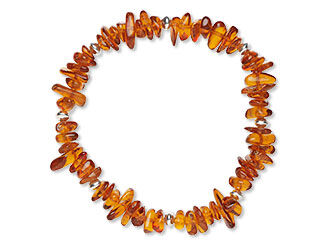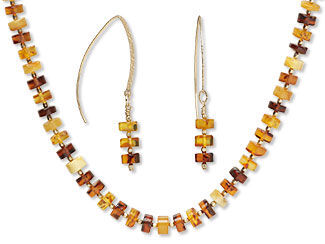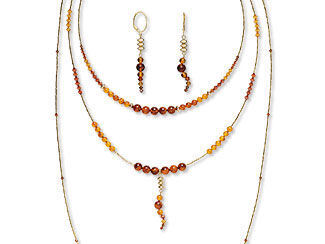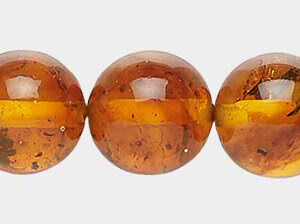Amber Meaning and Properties
Amber History
Blame it on Jurassic Park or the show Vikings—amber has captured imaginations for centuries. Among the Vikings, amber was believed to be the tears of Freyja, goddess of love and beauty. Her famed necklace, Brisingamen, was said to be made of gold and amber. To the ancient Greeks, amber was formed from the tears of Apollo’s daughters.
One of the most extravagant uses of amber in history was the Amber Room, a gift from Prussian King Frederick William I to Russian Czar Peter the Great. Eventually expanded to over 590 square feet and made with more than 13,000 pounds of amber, it mysteriously disappeared during World War II. A reconstruction was completed in St. Petersburg in 2003.
What are the Metaphysical Properties of Amber?
Amber is believed to absorb negative energy and radiate a warm, calming presence—like mental sunshine. Yellow amber, in particular, is thought by some natural healers to support memory, mental flexibility and balanced decision-making.
Historically, amber was used as a talisman for courage and self-confidence. In some cultures, it symbolizes wisdom, endurance and the renewal of vows or promises. These amber properties have made it a popular gemstone across generations and traditions.
What Chakra is Amber?
Chakras are energy centers believed to influence physical and emotional wellness. Amber is most often associated with the Solar Plexus Chakra, located just above the navel. This chakra governs personal power, clarity and emotional balance.
Wearing chakra bracelets that feature amber is said to help support confidence, motivation and mental strength. Amber’s warm, golden tones resonate with the Solar Plexus energy, helping to revitalize and cleanse this powerful energy center.
Solar Plexus Chakra (Manipura) - Yellow
- Location: navel (belly button)
- Represents: personal power; anxiety; forming opinions; fear; introversion; personal control
- Emotional issues: self-image; self-confidence; self-worth; expansiveness; transitions from simple emotions to complex ones
- Spiritual issues: growth; spiritual progress
- Physical issues: metabolism; digestion; energy; pancreatic troubles
- Gemstones: amber, citrine, yellow calcite, tigereye
Learn more in the full guide to chakras and designing chakra bracelets: Chakras and Their Gemstones.
What is Amber Made From?
Amber (pronounced AM-bur) is fossilized tree resin—formed more than 50 million years ago from prehistoric pine forests. These trees produced resin as a natural defense against insects and fungus. Over time, the molecules hardened and cross-linked into the gem we know today.
Pliny the Elder documented amber’s static properties in 79 AD—its ability to generate an electrical charge when rubbed. Raw amber may contain insects, plant matter, or even mammal hair, which adds value and fascination to each unique piece.
Only about 15% of all mined amber is suitable for jewelry. The rest is often pressed into "amberoid," a manufactured form made under heat and pressure. Natural amber floats in saltwater and releases a pine scent when tested with heat—two methods used to distinguish it from synthetics.
Major amber sources include Poland, Germany, Russia, Mexico, the Dominican Republic and the U.S. East Coast.
- Mineral Information: Not applicable
- Chemical Composition: C₁₀H₁₆O
- Color: Light yellow to brown, red, nearly colorless, white, blue, black, greenish
- Hardness: 2 to 2.5 (Mohs)
- Specific Gravity: 1.05 – 1.09 (up to 1.30)
- Refractive Index: 1.54
How Do You Clean Amber?
Amber properties make it delicate and require gentle care. Avoid steam, heat, ultrasonic cleaners and exposure to chemicals, perfumes, or alcohol. To clean amber, use room-temperature water with mild soap and soft cloth. Never expose it to open flame—amber is flammable.
Amber FAQs
Q: How many different types of amber are there?
A: There are over 200 recognized types of amber, but the most common categories are based on origin and appearance. The primary types include Baltic amber, Dominican amber, Mexican amber and Burmese amber. Variations also include colors like honey, butterscotch, green, red (cherry) and even blue, which is the rarest.
Q: How can you tell if amber is real or fake?
A: Real amber is lightweight, warm to the touch, and often contains natural imperfections or inclusions. Common tests include the saltwater float test (real amber floats), the UV light test (amber fluoresces blue or green) and the smell test (genuine amber gives off a pine-like scent when warmed or rubbed). Be cautious of plastics or resins passed off as amber.
Q: Can amber change color over time?
A: Yes, amber can darken or become cloudier as it ages, especially when exposed to light, heat, or air for extended periods. This oxidation process is natural and often adds to amber’s antique appearance and character.
Q: Is amber considered a mineral or an organic gemstone?
A: Amber is an organic gemstone, not a mineral. It is formed from fossilized tree resin and is one of the few organic substances used in fine jewelry, along with materials like coral and pearl.
Q: How old is the average piece of amber?
A: Most amber dates back between 30 to 90 million years, with Baltic amber typically estimated at around 44 million years old. The age contributes to its value and uniqueness.
Q: What metals pair best with amber in jewelry design?
A: Amber pairs beautifully with sterling silver, antiqued brass and warm-tone golds. Silver offers a cool contrast that enhances amber’s warmth, while brass and gold complement its earthy, organic tones.
Q: How long does it take for tree resin to fossilize into amber?
A: It takes millions of years for tree resin to harden and polymerize into true amber. The process begins with resin oozing from trees, gradually becoming copal and then—over extensive time and pressure—transforming into amber.
Q: How should amber jewelry be stored?
A: Store amber jewelry away from direct sunlight, heat and hard gemstones. Keep it in a soft pouch or lined box to prevent scratches, and avoid contact with chemicals, including perfumes, alcohol and household cleaners. Amber is soft and can be easily damaged if not cared for properly.
Designing with Amber
Amber’s warm glow makes it a standout choice in jewelry. From beads and chips to polished drops and cabochons, amber pairs beautifully with gold, silver, pearls, or gemstones like carnelian and black onyx.
Because it is lightweight and soft, amber is ideal for silk-strung designs—especially when knotted between beads. It also adds a radiant, earthy touch to chakra bracelet designs and statement pieces alike.
Whether you're creating something bold or subtle, amber offers endless possibilities for timeless style.
A Few Design Inspirations to Get You Started
Shop for Amber
**Please note that all metaphysical or healing properties listed are collected from various sources. This information is offered as a service and not meant to treat medical conditions. Fire Mountain Gems and Beads® does not guarantee the validity of any of these statements.
How did you like this resource? Your feedback helps us provide resources that matter to you most.
Copyright Permissions
All works of authorship (articles, videos, tutorials and other creative works) are from the Fire Mountain Gems and Beads® Collection, and permission to copy is granted for non-commercial educational purposes only. All other reproduction requires written permission. For more information, please email copyrightpermission@firemtn.com.




